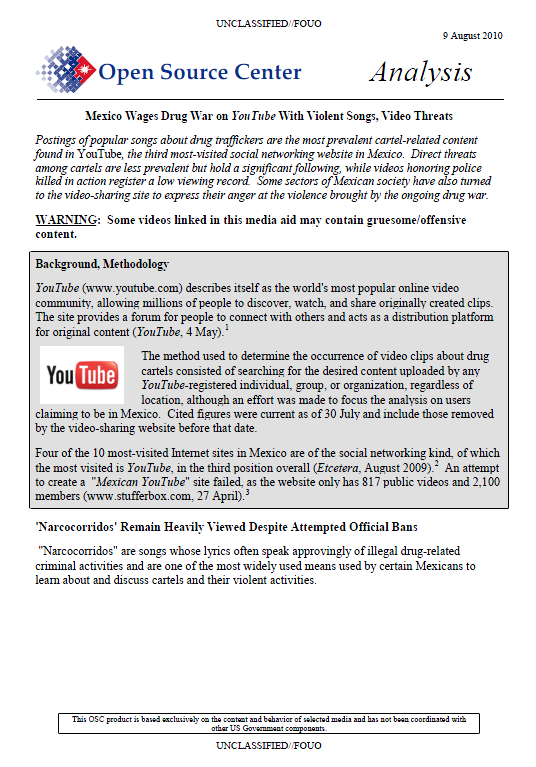 Mexico Wages Drug War on YouTube With Violent Songs, Video Threats
Mexico Wages Drug War on YouTube With Violent Songs, Video Threats
- 7 pages
- For Official Use Only
- August 9, 2010
Postings of popular songs about drug traffickers are the most prevalent cartel-related content found in YouTube, the third most-visited social networking website in Mexico. Direct threats among cartels are less prevalent but hold a significant following, while videos honoring police killed in action register a low viewing record. Some sectors of Mexican society have also turned to the video-sharing site to express their anger at the violence brought by the ongoing drug war.
WARNING: Some videos linked in this media aid may contain gruesome/offensive content.
Background, Methodology
YouTube (www.youtube.com) describes itself as the world’s most popular online video community, allowing millions of people to discover, watch, and share originally created clips. The site provides a forum for people to connect with others and acts as a distribution platform for original content (YouTube, 4 May).
The method used to determine the occurrence of video clips about drug cartels consisted of searching for the desired content uploaded by any YouTube-registered individual, group, or organization, regardless of location, although an effort was made to focus the analysis on users claiming to be in Mexico. Cited figures were current as of 30 July and include those removed by the video-sharing website before that date.
Four of the 10 most-visited Internet sites in Mexico are of the social networking kind, of which the most visited is YouTube, in the third position overall (Etcetera, August 2009). An attempt to create a “Mexican YouTube” site failed, as the website only has 817 public videos and 2,100 members (www.stufferbox.com, 27 April).
‘Narcocorridos’ Remain Heavily Viewed Despite Attempted Official Bans
“Narcocorridos” are songs whose lyrics often speak approvingly of illegal drug-related criminal activities and are one of the most widely used means used by certain Mexicans to learn about and discuss cartels and their violent activities.
- One important aspect of “narcocorridos” is their currency, as their updated lyrics are used to discuss ongoing events or status of cartels. For example, a new song written by Teodoro Bello and sung by Los Tigres del Norte is called “La Granja ” (“The Farm”), a metaphor for ongoing violence in Mexico that assigns specific characters to politicians, ordinary citizens, and cartels. The song compares the November 2008 plane crash that killed Interior Secretary Juan Camilo Mourino to a sparrow hawk that falls on “the farm,” representing the country of Mexico (YouTube, 24 November 2009).
- Wearing a ski mask, “MrTochtli” (which means “rabbit ” in the Aztecs’ Nahuatl language) says that his YouTube channel is dedicated to explain and promote the “outlawed ” narcocorridos which, in one of his pieces, he claims “tell the whole truth ” (YouTube, 17 August 2009).
“Narcocorridos ” and related video postings register the highest numbers of hits of any cartel-related YouTube communications.
- The narcocorrido music genre is widely present in YouTube. Los Tigres del Norte was the first group to start singing this type of song (Gomez, 1999). 7popular hit One called “La Camioneta Gris” (“The Gray Truck”) is a romantic story of a trafficker and his girlfriend fleeing police in a pick-up truck and reported more than 2 million hits on YouTube (31 July 2007).
- Another popular “narcocorrido ” is “El Gallo de Oro” (The Golden Rooster) by Valentin Elizalde, a young norteno singer among whose fans was Sinaloa Cartel chief Joaquin Guzman Loera, alias “Chapo,” and who was executed by the rival Gulf Cartel in 2006 after performing the song in that criminal organization’s operating area. Elizalde’s interpretation of the single “A mis enemigos” (“To my enemies”) had more than 2 million YouTube hits (9 May 2007).
- “Los Tucanes de Tijuana ” reported more than 1 million YouTube hits for their song “Cien por Uno ” (“One Hundred for One”), which tells the story of a drug lord’s brother forced to pay his murdered sibling’s enduring debt (YouTube, 18 January 2008).11 Baja California State officials accuse some of these “Norteno bands ” of having close ties to traffickers.
